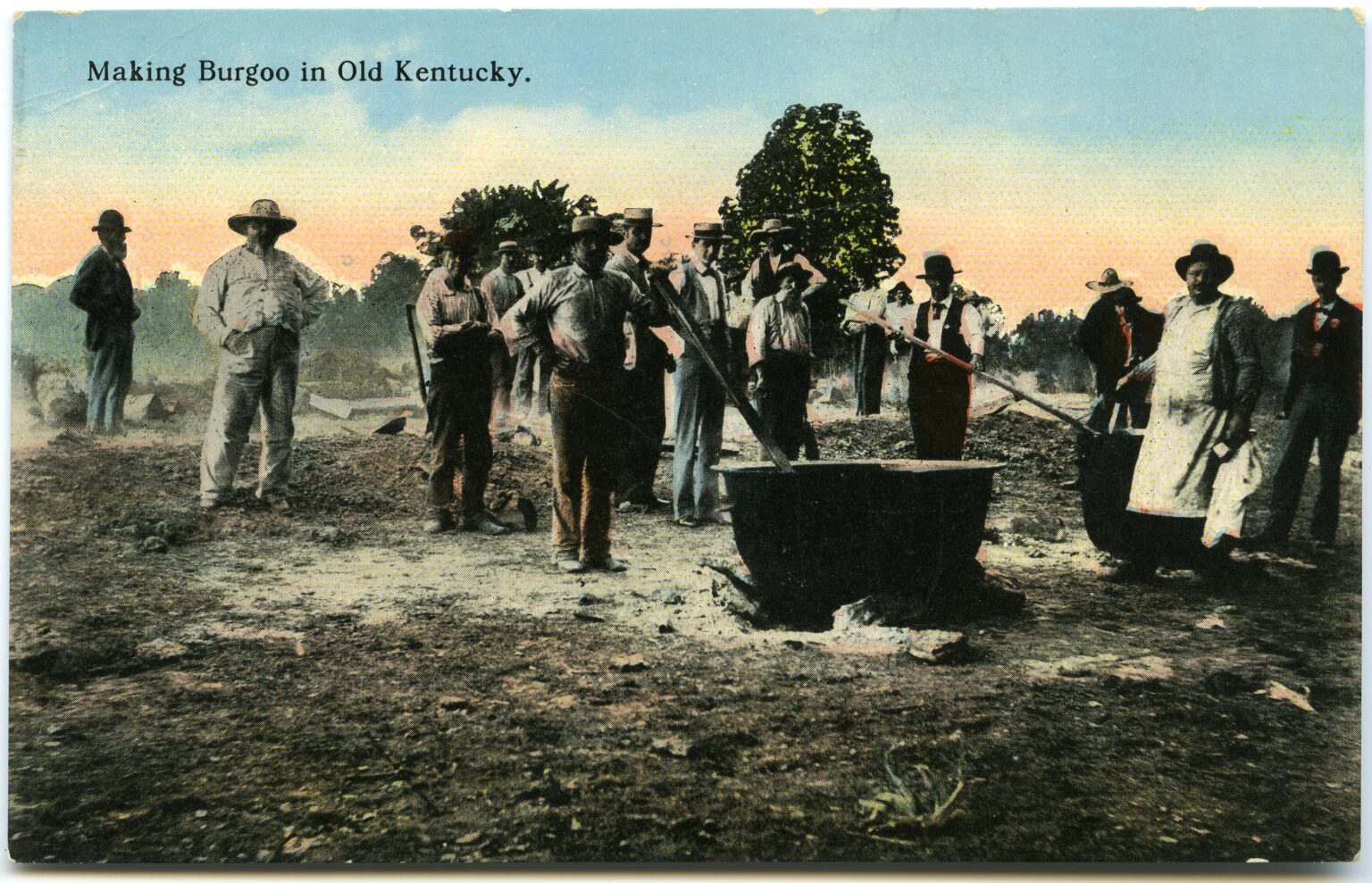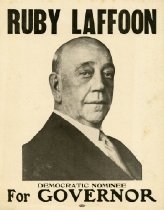5:30
Commentary
Commentary
Burgone?
No Wi-Fi needed for a political ‘feed’ in Kentucky’s past, just big kettles, open fires and a lot of grub

A handwritten note on the opposite side reads: “Democratic Barbecue at Winchester, Sept. – 1916, Hughes & Wilson campaign.” That year Democrat Woodrow Wilson of New Jersey defeated Republican Charles Evans Hughes of New York for the U.S. presidency. (University of Kentucky Libraries Special Collections Research Center)
Burgoo is long gone as a Kentucky campaign trail staple.
“Maybe Kentucky is too sophisticated for burgoo these days,” speculated Northern Kentucky Tribune columnist Bill Straub, a Kentucky Journalism Hall of Famer.?
He suspects that many Kentuckians, especially younger folks, have never heard of the famous stew that was served at political events for decades.
?“As a persuader in Kentucky politics and civics, burgoo has been well-nigh as widely used as barbecue,” B.A. Botkin explained in his 1949 book, “A Treasury of Southern Folklore, Kentucky Edition.”???
To be sure, Fancy Farm is famous for barbecue. But our largest and most famous political picnic is sans burgoo.
“A ‘burgoo’ is a cross between a soup and a stew, and into the big iron cooking kettles go, as we sometimes say in Kentucky, a ‘numerosity’ of things – meat, chicken, vegetables, and lots of seasonings,” explained Vice President Alben Barkley of Paducah in “That Reminds Me,” his 1954 memoir.
Botkin detailed an “old-timer’s” tried-and-true “numerosity:” “squirrel, quail, pa’t’idge, pheasant, wild turkey, field corn, barley, tomatoes, flour, celery, turnips, butter, cream, and…a little dash of Bourbon.”
Burgoo — pronounced “BUR-goo” by commoners and “bur-GOO” by the highfalutin — became so synonymous with Bluegrass State politics that a political rally which featured the concoction was called a “burgoo.”

There were big “burgoos” just about everywhere in Kentucky. Mayfield, the Graves County seat, hosted one of the largest on Oct. 17, 1931.?
The fete was for Ruby Laffoon of Madisonville, the Democratic gubernatorial candidate that lean Depression year.
Same as legions of other old-time Kentucky solons, Laffoon believed that the shortest path to voters’ hearts ran through their stomachs.
To feed the Mayfield multitude, more than 800 gallons of burgoo were brewed in 52 iron kettles over smoky blazes that reminded the hometown Messenge newspaper of “Chicago after a certain historic cow had kicked over a lantern and set fire to two thousand acres of property.”
Dr. Bow Reynolds was the “master of affairs and chief cook,” the paper said. (Nearly every Kentucky community of significant size boasted a local “burgooist.”)
Twenty sous chefs assisted the master. They stoked kettle fires and readied the fixin’s: 3,000 pounds of beef, 1,000 pounds of pork, 40 bushels of potatoes, 40 bushels of onions, 480 cans of tomatoes, 40 bushels of carrots, 1,200 roasting ears [of corn, pronounced “rosunears”], 40 gallons of peas, a bushel of red peppers and a gallon of garlic.
Around 7,000 people, evidently from throughout the old western Kentucky First Congressional District, congregated for the free burgoo and to hear stump speeches from Laffoon and his running mate, Albert B. “Happy” Chandler.
Everybody gathered on the old Mayfield High School football field, now Mayfield Middle School’s back campus. But burgoo central was across town at the Jackson Purchase stockyards.
Reynolds and his helpers started cooking the burgoo on the Thursday night before the Saturday rally.
“Down through the middle of a large covered stock pen is a long alley extending from one end to the other,” a “Messenger” reporter explained to readers. “On either side are stalls, formerly occupied by livestock but now inhabited by peelers of potatoes, carrots, onions and various other vegetables. In the alley is a row of forty old-fashioned iron kettles. Some are as large as a barrel in circumference, and others are larger.”
The writer encountered “pots boiling … and they had just sent for a dozen more.” The paper proposed that “no one person probably will ever know how many different things are in a batch of burgoo.” But the Messenger reassured readers that the burgoo contained nothing metallic since “all cans have been removed from around the tomatoes before they were dunked.”?
The correspondent described the stew as “a six-course dinner all boiled in one” and editorialized that “with proper seasoning burgoo can’t be anything but good and nutritious.”
While Dr. Reynold’s recipe called for beef and pork, frontier burgooists used wild game such as deer, elk, squirrels and rabbits. It’s been suggested that the varmint version was palatable only with a whiskey chaser. “Everything goes hand-in-hand with bourbon,” Straub proposed.
Anyway, the Mayfield burgoo was served in cardboard cartons with slaw and bread for sides. It took three hours to feed the multitude, according to the Messenger.
“There was plenty to eat,” the paper said. “Scores of gallons” went begging because Reynolds and his charges made enough burgoo for 10,000. Reportedly, the leftovers were given to a local charity for feeding the hungry.
The Democrats mostly ruled the Kentucky political roost in Laffoon’s day. So on Nov. 3, he easily beat the Republican standard bearer, Louisville Mayor William Benjamin Harrison.?
A footnote: Botkin cited the time in 1892 when a delegation of Philadelphians came to Lexington to help celebrate the centennial of Kentucky statehood. The visitors were told they’d be treated to “a burgoo” but they had no notion what that might be.
The men bedded down in the old Phoenix Hotel where in the wee morning hours, a shrieking peacock awakened one of them. “He nudged his bedfellow and said, ‘That must be the burgoo.’”
GET THE MORNING HEADLINES.
Our stories may be republished online or in print under Creative Commons license CC BY-NC-ND 4.0. We ask that you edit only for style or to shorten, provide proper attribution and link to our website. AP and Getty images may not be republished. Please see our republishing guidelines for use of any other photos and graphics.
Berry Craig
Berry Craig, a Carlisle countian, is a professor emeritus of history at West Kentucky Community and Technical College in Paducah and the author of seven books, all on Kentucky history. His latest is "Kentuckians and Pearl Harbor: Stories from the Day of Infamy" which the University Press of Kentucky published. He is a freelance journalist, a member of the American Federation of Teachers and a longtime union activist.





Berry Craig